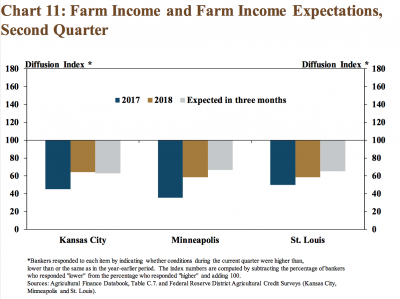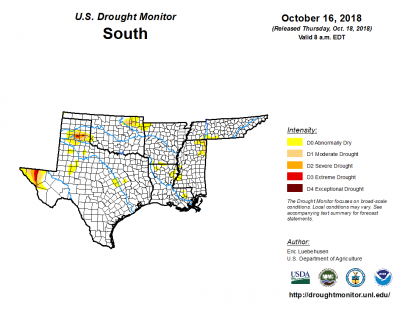Agriculture Secretary Brooke Rollins said on Tuesday that the Trump administration will announce a 'bridge payment' for farmers next week that is designed to provide short-term relief while longer trade…
Federal Reserve: Observations on the Ag Economy- October 2018
On Wednesday, the Federal Reserve Board released its October 2018 Beige Book update, a summary of commentary on current economic conditions by Federal Reserve District. The report included several observations pertaining to the U.S. agricultural economy.

* Sixth District- Atlanta– “Agriculture conditions across the District remained mixed. By late September, most of the District was drought-free. District corn, soybean, cotton, and peanut harvests were close to their five-year averages although by late September, significant rain in Tennessee resulted in some crop damage and delays in harvesting. Year-over-year prices paid to farmers in August were up for corn, cotton, rice, and eggs, while soybean, beef, and broiler prices were down.
Contacts remained concerned about tariffs and trade conflicts although there was some optimism concerning the newly agreed upon United States-Mexico-Canada Agreement.
“Recent reports indicated cropland values in the District rose from 2017 to 2018 with the exception of Florida where cropland values were flat.”
* Seventh District- Chicago– “Greater-than-usual precipitation slowed the harvest and reduced the quantity and quality of crops, and expectations for net crop income fell accordingly. While expectations for yields were lower than in the prior reporting period, it was still likely that they would reach record levels.
Contacts reported a notable drop in Chinese purchases of US soybeans following an increase in Chinese tariffs.
On average, 76% of U.S. #soybean shipments in October are to #China.
— Karen Braun (@kannbwx) October 23, 2018
Not this year though. Stats are alarming.
Bean inspections to China, Oct. 1-18: 134,729 t
Oct. 1-18, 2017: 3.42 mln t
YTD insp. to all destinations down 40% YOY.#AGTRIVIA pic.twitter.com/haipZID4ME
“Farmers also faced higher transportation costs due to rail issues, a shortage of truck drivers, and complications in shifting export destinations away from China. Contacts expected the record yields and weak export demand to push crop storage to abnormally high levels. Hog and dairy prices recovered some, boosted in part by US government purchases that were part of a program to compensate farmers for losses from higher foreign tariffs. Even so, dairy farmers continued to struggle. In addition, contacts viewed gains from the new US- Mexico-Canada Agreement as too small and too far in the future to help dairy farmers. Moreover, Canada and Mexico maintained their tariffs on agricultural goods (including pork and dairy) that they imposed in response to US steel and aluminum tariffs.”
* Eighth District- St. Louis– “District agriculture conditions improved slightly compared with previous reports. Production and yield forecasts increased from August to September for corn and soybeans. Expected production levels also improved for cotton and rice during the same period, but yield forecasts decreased. Relative to 2017, District corn, cotton, and soybean yields are expected to increase, but rice yields are projected to decline. Production levels of all four crops are expected to be greater than those from last year.”
* Ninth District- Minneapolis– “District agricultural conditions remained weak overall. Persistent rain in early fall delayed or slowed harvests in some areas. Very strong harvests were expected around the District, including potential record yields in some cases. However, commodity prices remained weak, and greater production was not expected to completely offset the negative impact of low prices on farm incomes. International demand for crops, particularly soybeans, has fallen dramatically, according to contacts. A producer of dry beans reported that a large regular annual order from European Union countries was cancelled due to tariffs.
A substantial number of dairy operations have exited the business since the beginning of the year.
* Tenth District- Kansas City– “The farm economy in the Tenth District remained weak as expectations of increased production contributed to a slight decline in corn and soybean prices since the previous reporting period.”

“Corn and soybean production was expected to be strong in Nebraska, which could offset some adverse effects of low prices. Crop yields in Missouri, however, weakened considerably from a year ago and could further strain farm income. The price of wheat was down slightly from the previous reporting period, but remained higher than a year ago. In the livestock sector, the price of cattle increased slightly from the previous period, but remained lower than a year ago as inventories generally remained high. In contrast to the prices of other agricultural commodities in the District, hog prices increased sharply in September due to expectations of lower production and higher exports.”
* Eleventh District- Dallas– “Drought conditions improved remarkably over the reporting period thanks to ample precipitation across much of the district.”

“While increased soil moisture will be a boon to the winter wheat crop, the rain came too late to help the 2018 row crops for which yields are expected to be down notably from last year. In fact, wet fields have to some extent hampered the harvesting efforts underway and could potentially cause quality issues for cotton. On the livestock side, conditions remained favorable with rising cattle prices, lower feed costs, and strong demand for beef.”
* Twelfth District- San Francisco– “Conditions in the agriculture sector improved somewhat, with crop yields generally beating expectations.
However, most contacts reported that trade policy changes started to have a tangible impact on activity. Yields and profits for growers in Central California continued to be satisfactory, but inventories of certain exported crops increased after delivery schedules were delayed due to trade policy uncertainty.
“Forward contracts for heavily exported crops declined. Wheat and fruit growers in Washington observed a slight tick down in demand, which some attributed to growing trade tensions.”





